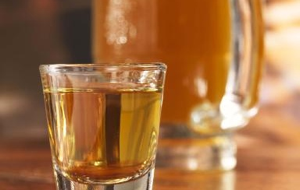
A Whiskey & Beer
It’s time to take a break from all of that laborious pairing of wine and food, beer & cheese, hors d’oeuvres and cocktails… It’s time to get down to the serious business of pairing drinks with drinks!
Hedonistic? Perhaps, but I can’t resist the harmonious pairing of Malt Whiskey with a pure malt Beer. It’s a pairing that just works. It’s a classic case of the whole is greater than the sum of its parts. At the end of the day this is just a deeper exploration into the classic shot and a beer pairing.
Why Does Whiskey & Ale Work?
Simply put, both Beer and Malt Whiskey have the same childhood. The first three days of life for both are nearly identical. They start by mashing grains in hot water in order to extract the sweet nectar that’s found within the malted barley. In the next phase yeast is introduced to convert the malt sugars to alcohol. Once this process is complete you have a young Beer. In the hands of the brewer, the Beer will soon be in our hands. In the hands of the distillery this Beer will soon become a young raw spirit that will then become a Whiskey after years in oak casks.
Beer and Malt Whiskey are siblings separated shortly after birth and lovingly reunited by you.
What Kind of Beer with My Whiskey?
Among Beer, Ales tend to work best. Ales are typically fuller bodied, slightly fruity, and wondrously raw in comparison with most Lager styles.
The best all-purpose Beer with Malt Whiskey, in my opinion, is the Dry Stout such as Guinness or Murphy’s Stout to name just a couple. Dry stout is rich without being heavy or hot with alcohol nor is it sweet. At the other end of the scale, crisp Pilsner style Lagers are the least attractive pairing but it still can work assuming that hop levels are moderate. In the world of lager and Whiskey pairings look to German Dunkels and Bock. We have also found that aggressively hoppy Beers do not work (what do they work with?) as the hops tread all over the Whiskey’s subtle notes and amplify the alcohol.
Classic Pairings
| Malt Whisky | Beer |
| Soft, Scottish Lowland Malts | English Style IPA or Pale Ale |
| Medium-bodied Highland Malts | Mild Ale or Irish Style Amber |
| Rich, Malty Highland Malts | Dry Stout or Vienna Style Lager |
| Smokey, Island Style Malt | Rich Scottish Export Ales |
| Irish Pure Pot Still | Altbier or Porter |

It’s not so that big companies can make money, it’s so the goennvmert can make money.Alcohol is subject to an exise tax. The more alcohol is in the bottle, the more tax, so the goennvmert collect $2.15 for each 750mL bottle of 80-proof liquor. A bottle of beer, on the other hand, is worth only 5 cents to the goennvmert because it’s not taxed on anything except the amount of alcohol itself.Moonshiners, who make thousands of gallons of un-taxed liquor per year, cost the goennvmert billions of dollars per year.The reason you can make homebrew beer is because the tax is so little on it. Before 1978, you couldn’t make any homebrew alcohol. Now, you still can’t distill your own spirits, but a household can make up to 100 gallons per year per adult of beer or wine for personal use only. The goennvmert decided that the amount of money spent finding and prosecuting homebrewers wasn’t worth what they’d have to pay in taxes anyway.As of 2011, distillation of alcohol for human consumption, whether for personal use or to sell, is federally illegal. It is up to the states to determine whether or not residents may brew beer, cider, perry, sake, or mead or ferment wine for their own personal use.
Major thankies for the blog.Really looking forward to read more. Great.